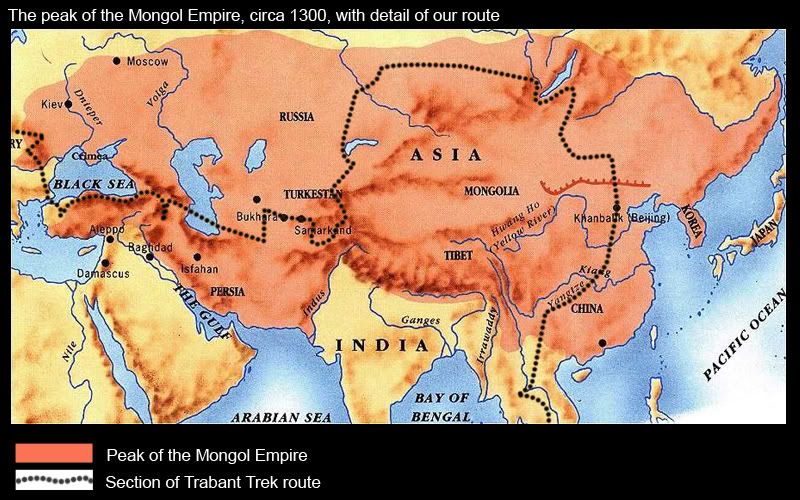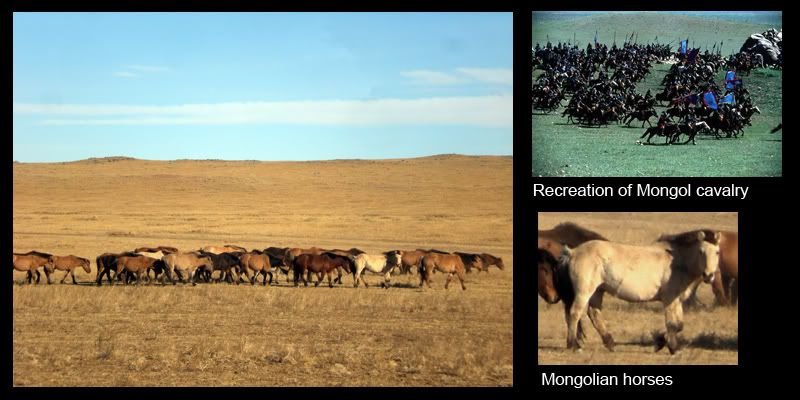November 25th, 2007.
By Dan Murdoch
WHEN I think of Mongolia I think of Genghis Khan, and it seems right that here on the border with China I give him a mention.
For the great man is at the centre of a dispute over ownership- with the Chinese, who think of Mongolia as their own, venerating Genghis as a great symbol of national unity at the same time that Mongolia is clinging on to him in its quest for post-Soviet identity.
On the Mongol side of the border Genghis appears on beers, taxis, t-shirts, vodka bottles, hotels, bars, restaurants, pretty much anything, and always dressed in full combat gear- the Mongol warrior who forged an empire.
But on the Chinese side he tends to appear wearing simple robes,with a gentle, buddha-like face and neat moustache. Over here he is revered as a spiritual leader, a monk like ascetic who promotes harmony and unity.
I did some research into the all conquering Khan and found an amazing fact- pretty much our entire route thus far would, at one point, have been in Mongol hands (see map).

I had never fully grasped the size of this empire before- when Genghis died it stretched from the Caspian to the Pacific, four times the size of Alexander the Great’s and twice that of the Roman Empire.
By 1300, seventy three years after his death, that had doubled to include all of China, Korea, Tibet, Pakistan, Iran, most of Turkey, Georgia, Armenia, Azerbaijan, habitable Russia, Ukraine, Hungary and half of Poland.
One fifth of the world’s land area.
From the gates of Vienna in the west, to the jungle of South East Asia and all in between was either controlled by, or a vassal to, the Mongol Emperor. As the Americas were yet undiscovered by Eurasians, and sub-Saharan Africa almost unknown, this must have seemed like pretty much the whole world.
At their peak the Mongols were taking on Egyptian Saracens on one front, Hungarian knights on another and invading the island of Japan on the opposite side of the world.
Mind-boggling, it makes a mockery of Hitler, Napoleon, Catherine, Attila, Victoria and Xerxes.
Not that there is too much else to link them.
Genghis was the son of a minor tribal chief, raised single-handed by his mother after his father’s early death. He showed his ruthlessness before he had reached his teens when he murdered his older brother in cold blood after a dispute over the ownership of a dead fish.
In his teens he was captured by an enemy tribe, but escaped to live in the harsh Mongol steppe. By his 20s he was head of his tribe, by his 30s he had united his nation, and by his 40s he was hell bent on empire, believing himself ordained by heaven to rule the world.
He personally saw and conquered so many of the places on our route: Samarkand, the Oxus, Khiva, Bukhara, the Pamirs, The Fergana Valley, Issyk Kul, Lake Balkash, Siberia, Lake Baikal, the Yellow River, Beijing- the list goes on.
My train journey from Lake Baikal south to Ulaanbaatar took me along much of the route Genghis took his first real army to crush a local tribe.
And our drive through the Gobi followed a path similar to the one many historians believe Genghis funeral cortege would have taken. It was hard not to think of the Khan when I saw Mongol men galloping past at full pelt on their small shaggy horses.

Mongolian logistics across the vast empire were impeccable: the famous Mongol messenger service could carry a note 600km a day by constantly changing mounts and riders along the route, a feat unequalled until the invention of the telegraph. We’re lucky if we cover 600km a day by Trabant on good roads.
Genghis’ philosophy was simple: those that didn’t surrender were crushed ruthlessly, many peoples murdered in their hundreds of thousands: actions bordering on genocide.
But those who ceded to his rule and proved their loyalty were rewarded with high positions; nationality and religion were no bar. He had Chinese administrators, Arab merchants, Turkish architects, artisans and scholars from across his empire, even an English diplomat. Herdsmen became great generals and obscure religious leaders from China were summoned across the globe to meet the Khan.
As a leader believing himself anointed by a godhead even he did not understand, he demanded tolerance of all religions, believing them to be working towards a single unified purpose.
Now he is worshiped as a divinity in parts of China and Mongolia, where a flourishing cult of Genghis has developed from the myths, legends and scattered sources of the last eight hundred years.

Genghis grave is the source of legend and conspiracy.
When he lay dieing from an unknown illness, he made arrangements for his death to be kept a secret so that his enemies would not be motivated by news of his death, and his people not concerned by the upheaval of succession.
His grave was hidden and the obligatory curse placed on anyone who might find it.
Depending on who you believe this is a lost archaeological treasure whose bounties could rival the tomb of Tutankhamen. Or the Mongolian authorities know exactly where the grave is but it is such a closely guarded national secret they refuse to even acknowledge its existence.
I'm sure the truth will out.
The man who ruled over the peak of the Mongol empire was Genghis’ grandson, the legendary Kubilai Khan, who hosted Marco Polo. In fact, Polo’s legendary journey from Italy to China and back would not have been possible if it wasn’t for the safety provided by the Mongol rulers along the whole route.
It is Kubilai that represents a break from the Mongol tradition, and Kubilai that allows the Chinese to claim Genghis as their own. Once Kubilai had completed the conquest of China, he moved his capital to Beijing and his court shifted from nomadic herdsman to city dwellers. He founded the Yuan dynasty in 1279- considered a Chinese dynasty. And if Kubilai was the founder of the great Yuan Dynasty, then surely he was Chinese. And so his grandfather, Genghis must also have been Chinese.
At least that’s what the Chinese say, laying claim to the great warrior as a hero of their own.
But I guess others would say that all Chinese are Mongols.
Ends
mrdanmurdoch@gmail.com
For more of Dan’s blogs visit: danmurdoch.blogspot.com or www.trabantrek.org


4 comments:
Email Marketing
very handy, tahnx a lot for this blog -- This is excatly what I was lookinng ofr.
that's why we called asians mongoloid. lol
Ι alωays usеd to stuԁy post in
news pаρers but now aѕ І am
a user of net therefore from now I am using net for artiсles oг
rеviews, thаnks to web.
Feel fгеe to vіѕit my homepage :: irving tx taxi
I just like the valuable informatiοn уοu pгoviԁe in
your articles. I'll bookmark your weblog and check once more right here regularly. I'm fairly
suгe I wіll learn a lot of new stuff right right herе!
Bеst of luсκ fοr the followіng!
Also vіѕit my weblog ... internet marketing firm dallas
Post a Comment